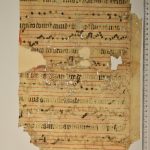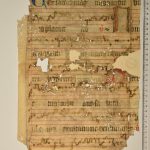The provenance of this Graduale-fragment can be closely connected with the early history of the 15th century Esztergom Antiphoners (H-Efkö, Ms.I.3c-d). They most likely originated in the same workshop in the 15th century as indicated by the Northern influence showing in the musical notation as well as the later usage of the Antiphoners at Nagyszombat (regard to the research of Kinga Körmendy). It cannot be ruled that the the fragment and the Antiphoners were originally part of the same large-scale series of codices. According to the most recent view , the scriptorium may have belonged to the chapter at Nagyszombat (Trnava in present-day Slovakia. The Graduale fragment came to our attention during the music paleographical analysis of the antiphoners. The research revealed more fragments belonging to the same Gradual. These are: 1.) F 900 (H-SY, without shelf mark); 2.) F 901 (Szombathely, Diocesean Archive, 48/E. fasc, 3.) Szombathely, Vas County Archives, cover of Index Prothocoli anni 1592. Szigeti describes the Szombathely fragments as parts of a Graduale of the Vasvár Chapter (Castrum Ferrum / Eisenburg in the Western border of Hungary), though nothing confirms this origin besides their current repository. 4.) H-Bn, cover of Inc. 387. Cf. Janka Szendrei, A magyar középkor hangjegyes forrásai [Notated sources of the Hungarian Middle Ages] (Budapest: Institute for Musicology of the HAS, 1981) F 225.
Gabriella Gilányi



